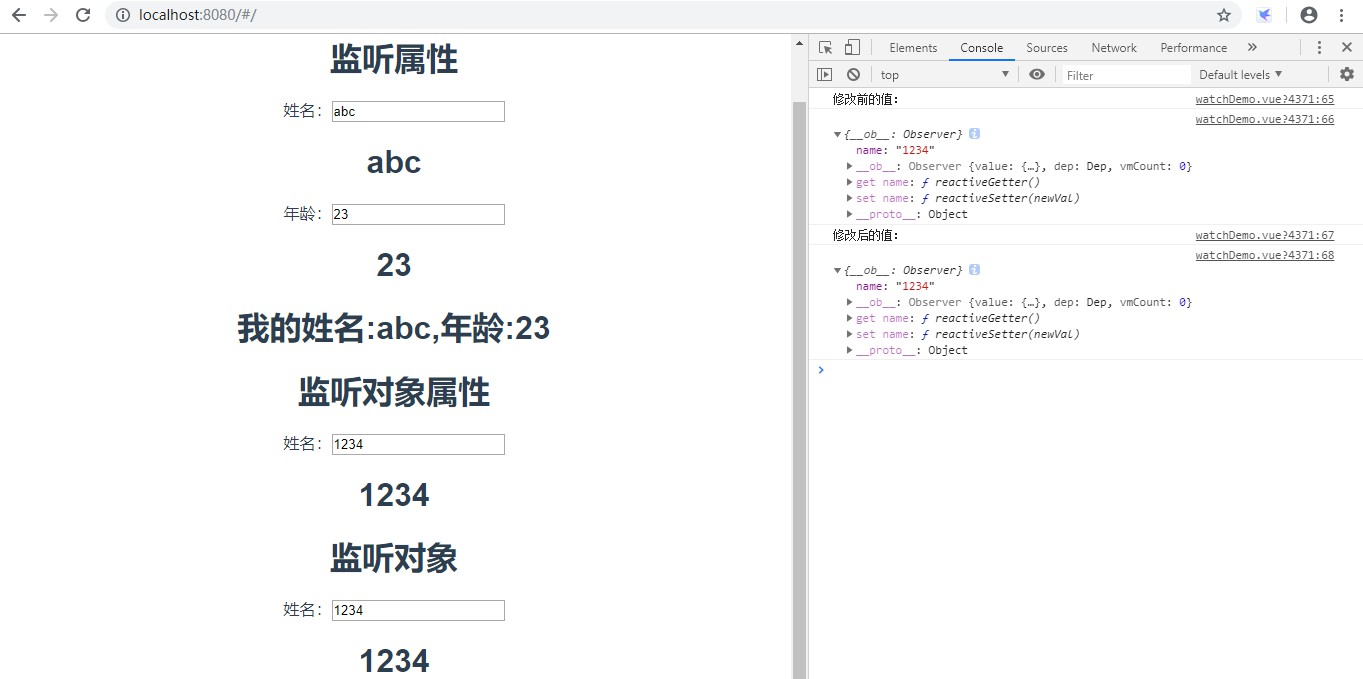Vue计算属性与监听属性
.NET开发菜鸟 人气:0一、为什么要使用计算属性
什么是计算属性
计算属性:可以理解为能够在里面写一些计算逻辑的属性。具有如下的作用:
- 减少模板中的计算逻辑。
- 数据缓存。当我们的数据没有变化的时候,不会再次执行计算的过程。
- 依赖固定的数据类型(响应式数据),不能是普通的传入的一个全局数据。
在数据量比较大的时候,计算属性可以帮助我们提高性能,因为计算属性只会在数据变化的时候才会计算。
在讲解计算属性之前先来看下面的一个例子:
需求:外卖套餐A每份15元,客户点了3份,总价打八折,配送费5元,要求在界面显示总价,代码如下:
<template>
<div>
<div>您购买了{{info.name}}共{{info.count}}份</div>
<h1>总价:{{info.count*info.price*info.sale+info.freight}}元</h1>
</div>
</template>
<script>
export default {
name:'Test',
data(){
return{
info:{
userId:1,
price:15,
name:'套餐A',
count:3,
sale:0.8,
freight:5
}
}
}
}
</script>界面运行效果:

看了上面的例子,可能有人会问:使用这种方式已经实现了需求,那为什么还要使用计算属性呢?我们知道,vue中模板内的表达式非常便利,设计的初衷是用于简单运算的。如果在模板中放入太多的逻辑会让模板过重而且难以维护,看上面的代码:
<h1>总价:{{info.count*info.price*info.sale+info.freight}}元</h1>在这段代码中,模板不在是简单的声明式逻辑,而是复杂的逻辑计算,如果想要在多处引用总价的时候,就会难以维护。所以,对于任何复杂的逻辑,都应当使用计算属性。
看下面使用计算属性的例子:
<template>
<div>
<h1>计算属性</h1>
<div>您购买了{{info.name}}共{{info.count}}份</div>
<!--使用计算属性:和绑定普通属性一样-->
<h1>总价:{{totalPrice}}元</h1>
</div>
</template>
<script>
export default {
name:'ComputedDemo',
data(){
return{
info:{
userId:1,
price:15,
name:'套餐A',
count:3,
sale:0.8,
freight:5
}
}
},
computed:{
// 定义计算属性totalPrice
totalPrice:function(){
return this.info.count*this.info.price*this.info.sale+this.info.freight
}
}
}
</script>界面显示效果:

注意:计算属性是一个属性,不是方法,不能写在methods中,放在computed属性里面。
上面计算属性的写法也可以使用ES6的写法:
// 使用ES6写法
totalPrice(){
return this.info.count*this.info.price*this.info.sale+this.info.freight
}二、计算属性和方法的区别
1、区别
上面的例子除了使用计算属性,还可以使用方法实现:
<template>
<div>
<h1>计算属性</h1>
<div>您购买了{{info.name}}共{{info.count}}份</div>
<!--使用计算属性:和绑定普通属性一样-->
<h1>使用计算属性获取总价:{{totalPrice}}元</h1>
<h1>使用方法获取总价:{{getTotalPrice()}}元</h1>
</div>
</template>
<script>
export default {
name:'ComputedDemo',
data(){
return{
info:{
userId:1,
price:15,
name:'套餐A',
count:3,
sale:0.8,
freight:5
}
}
},
computed:{
// 定义计算属性totalPrice
// totalPrice:function(){
// return this.info.count*this.info.price*this.info.sale+this.info.freight;
// }
// 使用ES6写法
totalPrice(){
return this.info.count*this.info.price*this.info.sale+this.info.freight;
}
},
methods:{
getTotalPrice(){
return this.info.count*this.info.price*this.info.sale+this.info.freight;
}
}
}
</script>界面显示效果:

通过上面的例子可以看出:计算属性和方法实现的最终效果是相同的。那么计算属性和方法有什么区别呢?计算属性是基于它们的响应式依赖进行缓存的,只有在响应式依赖发生改变时才会重新求值。这就意味着只要响应式依赖没有发生改变,多次访问计算属性会立即返回之前的计算结果,而不必再次执行计算。相比之下,调用方法总会再次执行函数。总价计算属性和方法的区别如下:
- 计算属性在依赖发生改变时会自动改变,而方法在依赖发生改变时需要触发才会改变。
- 计算属性在依赖发生改变时才会重新计算,而方法在每次调用时都会执行。
看下面的例子:
<template>
<div>
<h1>计算属性</h1>
<!-- <div>您购买了{{info.name}}共{{info.count}}份</div> -->
<!-- 使用计算属性:和绑定普通属性一样 -->
您购买了<input type="text" v-model="info.name" />
数量<input type="text" v-model="info.count" />
<h1>使用计算属性获取总价:{{totalPrice}}元</h1>
<button @click="getTotalPrice">计算属性</button>
<h1>使用方法获取总价:{{data}}元</h1>
</div>
</template>
<script>
export default {
name:'ComputedDemo',
data(){
return{
info:{
userId:1,
price:15,
name:'套餐A',
count:3,
sale:0.8,
freight:5
},
data:0
}
},
computed:{
// 定义计算属性totalPrice
// totalPrice:function(){
// return this.info.count*this.info.price*this.info.sale+this.info.freight;
// }
// 使用ES6写法
totalPrice(){
console.log('计算属性');
return this.info.count*this.info.price*this.info.sale+this.info.freight;
}
},
methods:{
getTotalPrice(){
console.log('方法');
this.data= this.info.count*this.info.price*this.info.sale+this.info.freight;
}
}
}
</script>当依赖发生改变时会多次打印“计算属性”,而方法需要在点击按钮的时候才会发生改变。依赖不发生改变时点击按钮,也会打印“方法”。如下图所示:

2、计算属性使用场景
假如我们有一个性能开销比较大的计算属性A,它需要遍历一个巨大的数组并做大量的计算,然后我们可能有其他的计算属性依赖于计算属性A。如果不使用计算属性,那么将不可避免的多次进行计算,会消耗很大的性能,这种情况下就需要使用计算属性。
三、修改计算属性的值
在上面的例子中都是使用的获取后的计算属性的值,那么如何修改计算属性的值呢?看下面的例子:
<template>
<div>
<h1>修改计算属性</h1>
<h2>num:{{num}}</h2>
<h2>计算属性num2:{{num2}}</h2>
<button @click="change">改变计算属性的值</button>
</div>
</template>
<script>
export default {
name:'ComputedDemo2',
data(){
return{
num:100
}
},
computed:{
num2(){
return this.num-10;
}
},
methods:{
change(){
this.num2=60;
}
}
}
</script>效果:

这时会发现直接修改计算属性的值报错了,因为不能直接修改计算属性的值,如果要修改计算属性的值,需要修改其依赖项的值,看下面的代码:
<template>
<div>
<h1>修改计算属性</h1>
<h2>num:{{num}}</h2>
<h2>计算属性num2:{{num2}}</h2>
<button @click="change">改变计算属性的值</button>
</div>
</template>
<script>
import { get } from 'http';
export default {
name:'ComputedDemo2',
data(){
return{
num:100
}
},
computed:{
num2:{
// 当计算属性要修改时先触发set方法
// 读取当前计算属性中的值,get方法可以隐藏,默认进入的是get方法
get:function(){
return this.num-10;
},
set:function(val){
this.num=val;
}
}
},
methods:{
change(){
// 计算属性不能直接修改
this.num2=60;
}
}
}
</script>修改前的效果:

修改后的效果:

总结
计算属性的值不能修改,如果要修改计算属性的值,要通过计算属性里面的set方法修改其依赖项的值才能修改计算属性的值。
四、监听属性
监听属性(watch)是用来监听data中的数据是否发生变化,一般是监听data中的某个属性。
- 更加灵活、通用的API。
- watch中可以执行任何逻辑,如函数节流,Ajax异步获取数据,甚至操作DOM。
1、监听普通属性
看下面的代码:
<template>
<div>
<h1>监听属性</h1>
姓名:<input type="text" v-model="userName"/>
<h1>{{userName}}</h1>
年龄:<input type="text" v-model="age"/>
<h1>{{age}}</h1>
</div>
</template>
<script>
export default {
name:'watchDemo',
data(){
return{
userName:"abc",
age:23
}
},
methods:{
change(){
}
},
watch:{
// 监听userName的变化
// 有两个参数,newValue表示变化后的值,oldValue表示变化前的值
userName:function(newValue,oldValue){
console.log('修改前的值:'+oldValue);
console.log('修改后的值:'+newValue);
},
// 监听age的变化
age:function(newValue,oldValue){
console.log('修改前的值:'+oldValue);
console.log('修改后的值:'+newValue);
}
}
}
</script>界面效果:

2、监听属性和计算属性的区别
监听属性和计算属性的区别主要有下面几点:
计算属性性能更优。一个监听属性只能监听一个属性的变化,如果要同时监听多个,就要写多个监听属性,而计算属性可以同时监听多个数据的变化。监听属性可以获取改变之前的属性值。计算属性能做的,watch都能做,反之则不行。能用计算属性尽量用计算属性。
需求:userName或age改变的时候打印出当前的userName和age值。
用监听属性实现:
<template>
<div>
<h1>监听属性</h1>
姓名:<input type="text" v-model="userName"/>
<h1>{{userName}}</h1>
年龄:<input type="text" v-model="age"/>
<h1>{{age}}</h1>
<!--打印userName和age的值-->
<h1>{{info}}</h1>
</div>
</template>
<script>
export default {
name:'watchDemo',
data(){
return{
userName:"abc",
age:23,
info:''
}
},
methods:{
change(){
}
},
watch:{
// 监听userName的变化
// 有两个参数,newValue表示变化后的值,oldValue表示变化前的值
userName:function(newValue,oldValue){
// console.log('修改前的值:'+oldValue);
// console.log('修改后的值:'+newValue);
this.info= '我的姓名:'+ this.userName+',年龄:'+this.age;
},
// 监听age的变化
age:function(newValue,oldValue){
// console.log('修改前的值:'+oldValue);
// console.log('修改后的值:'+newValue);
this.info= '我的姓名:'+ this.userName+',年龄:'+this.age;
}
}
}
</script>如果要实现上述的需求,则需要对userName和age都进行监听,监听属性里面的代码都是重复的,如果有多个,那么就要写多个监听属性。在看计算属性:
<template>
<div>
<h1>监听属性</h1>
姓名:<input type="text" v-model="userName"/>
<h1>{{userName}}</h1>
年龄:<input type="text" v-model="age"/>
<h1>{{age}}</h1>
<!--打印userName和age的值-->
<!-- <h1>{{info}}</h1> -->
<!--使用计算属性-->
<h1>{{getUserInfo}}</h1>
</div>
</template>
<script>
export default {
name:'watchDemo',
data(){
return{
userName:"abc",
age:23,
info:''
}
},
methods:{
change(){
}
},
// watch:{
// // 监听userName的变化
// // 有两个参数,newValue表示变化后的值,oldValue表示变化前的值
// userName:function(newValue,oldValue){
// // console.log('修改前的值:'+oldValue);
// // console.log('修改后的值:'+newValue);
// this.info= '我的姓名:'+ this.userName+',年龄:'+this.age;
// },
// // 监听age的变化
// age:function(newValue,oldValue){
// // console.log('修改前的值:'+oldValue);
// // console.log('修改后的值:'+newValue);
// this.info= '我的姓名:'+ this.userName+',年龄:'+this.age;
// }
// }
computed:{
getUserInfo(){
return '我的姓名:'+ this.userName+',年龄:'+this.age;
}
}
}
</script>如果使用计算属性则只需要写一次就可以实现上面的需求了。
3、监听复杂对象
上面的例子中是监听的普通属性,那么如何监听对象里面的属性呢?看下面的代码:
<template>
<div>
<h1>监听属性</h1>
姓名:<input type="text" v-model="userName"/>
<h1>{{userName}}</h1>
年龄:<input type="text" v-model="age"/>
<h1>{{age}}</h1>
<!--打印userName和age的值-->
<!-- <h1>{{info}}</h1> -->
<!--使用计算属性-->
<h1>{{getUserInfo}}</h1>
<!--监听对象属性-->
<h1>监听对象属性</h1>
姓名:<input type="text" v-model="obj.name"/>
<h1>{{obj.name}}</h1>
</div>
</template>
<script>
export default {
name:'watchDemo',
data(){
return{
userName:"abc",
age:23,
info:'',
// 对象
obj:{
name:'123'
}
}
},
methods:{
change(){
}
},
watch:{
// 监听userName的变化
// 有两个参数,newValue表示变化后的值,oldValue表示变化前的值
userName:function(newValue,oldValue){
// console.log('修改前的值:'+oldValue);
// console.log('修改后的值:'+newValue);
this.info= '我的姓名:'+ this.userName+',年龄:'+this.age;
},
// 监听age的变化
age:function(newValue,oldValue){
// console.log('修改前的值:'+oldValue);
// console.log('修改后的值:'+newValue);
this.info= '我的姓名:'+ this.userName+',年龄:'+this.age;
},
// 监听对象中属性的变化
'obj.name':function(newValue,oldValue){
console.log('修改前的值:'+oldValue);
console.log('修改后的值:'+newValue);
}
},
computed:{
getUserInfo(){
return '我的姓名:'+ this.userName+',年龄:'+this.age;
}
}
}
</script>效果:

能不能执行监听对象呢?答案是可以的,看下面代码:
<template>
<div>
<h1>监听属性</h1>
姓名:<input type="text" v-model="userName"/>
<h1>{{userName}}</h1>
年龄:<input type="text" v-model="age"/>
<h1>{{age}}</h1>
<!--打印userName和age的值-->
<!-- <h1>{{info}}</h1> -->
<!--使用计算属性-->
<h1>{{getUserInfo}}</h1>
<!--监听对象属性-->
<h1>监听对象属性</h1>
姓名:<input type="text" v-model="obj.name"/>
<h1>{{obj.name}}</h1>
<!--监听对象-->
<h1>监听对象</h1>
姓名:<input type="text" v-model="obj.name"/>
<h1>{{obj.name}}</h1>
</div>
</template>
<script>
export default {
name:'watchDemo',
data(){
return{
userName:"abc",
age:23,
info:'',
// 对象
obj:{
name:'123'
}
}
},
methods:{
change(){
}
},
watch:{
// 监听userName的变化
// 有两个参数,newValue表示变化后的值,oldValue表示变化前的值
userName:function(newValue,oldValue){
// console.log('修改前的值:'+oldValue);
// console.log('修改后的值:'+newValue);
this.info= '我的姓名:'+ this.userName+',年龄:'+this.age;
},
// 监听age的变化
age:function(newValue,oldValue){
// console.log('修改前的值:'+oldValue);
// console.log('修改后的值:'+newValue);
this.info= '我的姓名:'+ this.userName+',年龄:'+this.age;
},
// 监听对象中属性的变化
// 'obj.name':function(newValue,oldValue){
// console.log('修改前的值:'+oldValue);
// console.log('修改后的值:'+newValue);
// }
// 直接监听对象
obj:{
// handler表示默认执行的函数
handler(newValue,oldValue){
console.log('修改前的值:')
console.log(oldValue);
console.log('修改后的值:');
console.log(newValue);
},
// 表示深度监听
// true:表示handler函数会执行
// false:表示handler函数不会执行
deep:true
}
},
computed:{
getUserInfo(){
return '我的姓名:'+ this.userName+',年龄:'+this.age;
}
}
}
</script>效果:

GitHub代码地址:https://github.com/JiangXiaoLiang1988/computed.git
加载全部内容